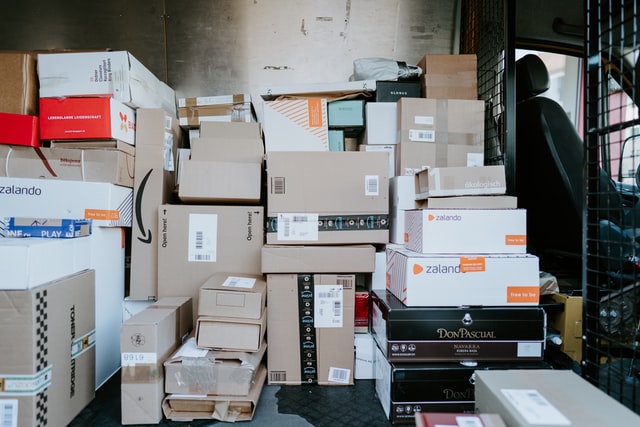According to Statista, in 2020, retail e-commerce sales worldwide totaled $4.28 Trillion Dollars, while e-retail revenues are predicted to reach $5.4 Trillion Dollars by 2022.
On the other hand, total revenue from e-Commerce alone in the USA amounted to $431.6 Billion Dollars in 2020, with Statista projecting that it will increase to $563.4 billion dollars by 2025.
All things considered, right after Asia (especially China), North America will remain the world’s second-largest eCommerce market and continue to see double-digit growth in the foreseeable future.
And a major challenge for foreign companies is how to dip their fingers in this profitable honeypot and start selling products online in the USA.
Challenges companies face when trying to sell in the USA

Generally speaking, it is usually highly challenging for manufacturers outside of the USA to find easy ways to sell their products online to the US market. For the most part, selling through large online marketplaces like Amazon and eBay is not a straightforward feat due to a number of reasons we shall delve into.
The US-China trade war has only added to the woes of manufacturers (especially in Southeast Asia) looking to sell online. This has impacted the global furniture industry more than ever since the announcement of COVID-19 pandemic by World Health Organization (WHO) in March 2020. Not to forget, the antidumping and countervailing duties in US.
Firstly, having direct communication channels with Amazon and eBay can be a nightmare for third parties and small manufacturers, as well as getting approval for their products.
Not to mention the convoluted tariff structure in the US, complicated consumer laws, custom and bonded warehousing regulations, ground shipment processes, and challenges with making actionable connections with the appropriate online retail brands for redistribution.
Overall, the major challenges for foreign manufacturers venturing into USA online markets revolve around logistics, for example:
- Demand planning can be complicated as companies must forecast how much demand for a product there could be, and how to create demand for their product through promotional activities.
- Supply chain execution can be a source of overwhelming uncertainty. For instance, in case there is an increment in the demand for an item and inventory is less, or out of stock, how fast can the manufacturer restock it? Additionally, how fast can the manufactured product be transported to successfully meet customer orders?
- Warehouse and Inventory Management can also pose overarching issues. Without optimal order fulfillment strategies to help meet customers’ expectations, serving the USA market can be challenging as some regularly ordered products have to somehow always be available on the major website’s inventory (like Amazon) to avoid disconcerting consumers.
- Organized logistics planning can be complicated as it constitutes organizing and coordinating the channels employed for delivering products to end consumers as well as carefully monitoring the time it takes to complete the order successfully.
How to enter the USA online market?
Foreign companies with plans to enter the USA online market have two main possibilities.
Either going to the USA and building a local business themselves.
OR
Partnering with an order fulfillment company for e-Commerce that maintains already well-established processes, logistical mechanisms and good experience with American buyers.
However, there is a possible third, manual route that entails creating a website to display the products, then attracting potential customers through list building, then somehow selling and dealing with the logistical elements in-house. This route is highly cumbersome and resource-intensive.
As such, you are better off exploiting existing e-Commerce platforms like eBay and Etsy that already have a customer base and help you cut the hustle of building email lists and laborious digital marketing. This could be done using the dropshipping concept for the manufacturers.
Check out the article direct exporting vs dropshipping supplier to determine which one is a better option for you as a manufacturer or brand.
Since it’s prudent to exploit USA-based e-Commerce platforms, the bigger challenge is shipping or delivering the products to the USA to sell!
Approaches to ship or deliver products for online sale in the USA

More than three-quarters of American consumers have ever made a purchase on Amazon, with over half of them currently possessing a Prime account. To access this exciting market base, foreign manufacturers have four key forms of logistical approaches they can employ:
1. Insourcing Logistics
In this e-Commerce logistical model, manufacturers perform most of the logistics processes themselves. However, this approach is sometimes ineffective for micro and small enterprises, where the scale of activity is still too small.
Though, this logistical approach allows for better control of their business and independence from subcontractors.
Furthermore, this model is advisable for companies that can easily scale their operations. For example, as orders increase, they need to have the capacity to hire more people, buying or renting more warehouse space, especially in so-called seasonal peaks.
2. Dropshipping
By definition, dropshipping entails the shipment of goods directly from the warehouse of a manufacturer/distributor to the consumer, .
This service comprises in-storage of products, taking orders and completing them, issuance of sales documents and shipping packages to customers.
Generally, medium-sized companies that don’t want to risk freezing their assets in inventory, especially when they increase the number of their product items, are typically interested in dropshipping. Ultimately, this model enables manufacturers to focus on acquiring customers.
Principally, there are two main types of dropshipping. Firstly, pure dropshipping, where the online store doesn’t maintain a warehouse and depends on external firms implementing order fulfilment processes. Secondly, partial dropshipping, where only selected items are stored in a third-party company’s warehouse.
That being said, pure dropshipping is recommended if the offered products are from a single supplier with a wide range of items. However, if goods originate from multiple suppliers, this results in higher costs and can cause miscommunication issues.
Therefore, dropshipping necessitates developing appropriate procedures for the flow of information, returns, packaging, and payments.
3. One-Stop e-Commerce
One-stop eCommerce services encompass the entire e-Commerce supply chain, from logistics to customer service, marketing, IT solutions, finance, and accounting. For instance, they can comprise call centers to deal with inquiries and complaints on behalf of the client in multiple languages.
Overall, one-stop e-Commerce services act as an extension of fulfillment services by simply providing additional services. Generally, this service allows for better task coordination and communication between the parties with integrated processes all in one place.
However, it is always a risk to entrust all e-Commerce processes to one partner if you are a small manufacturer. Therefore, this model is mainly employed by established large companies, for which e-Commerce is simply an additional sales channel. With that being said, you could check out the order fulfillment strategies for your eCommerce business before deciding whether it’s suitable for you.
4. Fulfillment Services
Fulfillment services entail delegating most logistic processes to an external provider like order registering, storage, processing, equipment and order packaging. To better describe the need for fulfillment services, let’s peddle back and see what it takes to manually sell on Amazon or eBay.
Manually selling in the USA on Amazon or eBay
Fortunately, Amazon or eBay allow manufacturers from around the world to sell goods of all types.
However, if you choose to sell your products by yourself to the US market, there are several requisites demanded and processes you have to go through:
- A fully registered company
- Possessing a retail license
- A functional website (for credibility)
- Employer Identification Number (EIN) to open a US bank account
- Export licenses
- Import-export code
- Partnerships with international air freight service providers like Aramex, DHL, FedEx or UPS.
- Good packaging, product descriptions and photography
- A seller account on Amazon or eBay
The above requirements are just a starting point before you get into the logistical elements, warehousing challenges, USA tax regulations, and accounting hustles. To avoid this headache, it is better to go through an end-to-end fulfillment service with pre-established connections with these big online stores.
Why use a fulfillment agency and how do they work?

Essentially, order fulfillment services take over part of the manufacturer or seller’s logistics processes, from reception, storage, picking, packaging to sending the goods via an external operator.
In practice, products ordered are sent to the fulfillment agency’s warehouse, then unloaded, inspected, stored, packed and shipped on behalf of the client.
The agency manages the warehouse, checks the inventory, takes orders from final consumers, packages shipments, prepares sales documents and shipping ones, then attaches manuals, helps in customs clearance, handles returned goods, and co-operates with transport companies.
Specialist fulfillment operators are very flexible and can adapt to the variability of the demand of their clients depending on their needs.
For example, they can increase or lessen the storage area or the number of employees in peak seasons. They also prepare reports on their activities for the client with regards to the sales volume, number of returns, or complaints.
Some agencies even undertake repairs, refreshing and disposal of returned products.
However, the key activities of fulfillment operators are related to storage. While working with businesses, fulfillment agencies are always prepared for many contingencies that could arise at any stage of the service realization.
For example, an agency must be able to serve customers from industries that differ in their specifics, like electronic products, which are often high market value commodities that require additional safety procedures for logistic handling.
Benefits of using a fulfillment agency
- Fulfillment agencies easily scale with the client’s business needs and comfortably withstand seasonal sales jumps that involve peak loads, without losing service quality.
- They also offer business extensibility as clients can be engaged in advertising, marketing and promotion, without necessarily being distracted by background logistical processes. As a result, companies can easily increase the volume of their shipments.
- They offer lower delivery costs as the cost of a fulfillment operator to process one order is much lower because of already adjusted business processes.
- They save businesses a lot of time by handling warehousing, routing of cargo, processing orders, software, logistics processes, and legislation. Generally, small companies can’t afford to open logistics departments or hire competent people responsible for all parts of the logistics supply chain, with the same quality. On the other hand, large companies with their own logistics departments incur great expenses, especially at the start.
- Fulfillment agencies also provide their clients comprehensive analytics on the orders as they process large amounts of information daily, which they can store, systematize and analyze.
- Fulfillment partners centrally collect goods in instances where an online shop or manufacturer works directly with different delivery companies. Here, each courier can arrive for their respective order, but everyone has to be paid.
Fulfillment agencies simply picks up all the orders and distribute them accordingly between couriers independently, thus saving time and facilities for the client.
For more information, read our article on “Why do you need to outsource fulfillment services when shipping to the USA?”
Final thoughts
Overall, the best way to sell products in the USA is via order fulfillment agencies. Small businesses already face a myriad of challenges during their operations, and cross border logistical issues should not be one of them.
Therefore, it is always an intelligent move to work with an order fulfillment agency to handle all the necessary processes to sell in the USA.
As has been noted, order fulfillment agencies also typically minimize the costs associated with the logistics process, allowing companies to dedicate more time to marketing and branding, etc.
Furthermore, fulfillment agencies usually bring in their technical know-how, which includes modern technology for warehouse management, which, especially at a larger scale, deliver benefits in quality, time, cost.





